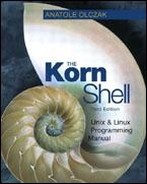In-Line Editors
In-line editing provides the ability to edit the current or previous commands before executing them. There are three in-line editing modes available: emacs, gmacs, and vi. The emacs and gmacs modes are basically the same, except for the way Ctl-t is handled. The inline editing mode is specified by setting the EDITOR or VISUAL variables, or with the set –o command. The editing window width is specified by the COLUMNS variable. For lines longer than the window width, a mark is displayed to notify position. The marks >, <, and * specify that the line extends to the right, left, or both sides of the window.
Vi Input Mode Commands
| #, <Backspace> | delete previous character |
| Ctl-d | terminate the Korn shell |
| Ctl-v | escape next character |
| Ctl-w | delete previous word |
| Ctl-x, @ | kill the entire line |
| <Return> | execute current line |
| escape next erase or kill character |
Vi Motion Edit Commands
| [n]h, [n]<Backspace> | move left one character |
| [n]l, [n]<Space> | move forward one character |
| [n]b | move backward one word |
| [n]B | move backward one word; ignore punctuation |
| [n]w | move forward one word |
| [n]W | move forward one word; ignore punctuation |
| [n]e | move to end of next word |
| [n]E | move to end of next word; ignore punctuation |
| [n]fc | move forward to character c |
| [n]Fc | move backward to character c |
| [n]tc | move forward to character before character c |
| [n]Tc | move backward to character before character c |
| [n]; | repeat last f, F, t, or T command |
| [n], | repeat last f, F, t, or T command, but in opposite direction |
| 0 | move cursor to start of line |
| ^ | move cursor to first non-blank character in line |
| $ | move cursor to end of line |
Vi Search/Edit History Commands
Vi Text Modification Commands
Vi Other Edit Commands
| u | undo last text modification command |
| U | undo text modification commands on current line |
| [n]v | return output of fc –e command |
| Ctl-l | redisplay current line |
| Ctl-j | execute current line |
| Ctl-m | execute current line |
| # | insert a # (comment) at beginning of current line |
| = | list files that match current word* |
| * | replace current word with files that match word* |
| @_c | insert value of alias c |
Emacs/Gmacs In-Line Editor Commands
| Ctl-b | move left one character |
| Ctl-f | move right one character |
| Esc-b | move left one word |
| Esc-f | move right one word |
| Ctl-a | move to beginning of line |
| Ctl-e | move to end of line |
| Ctl-h | delete preceding character |
| Ctl-x | delete the entire line |
| Ctl-k | delete from cursor to end of line |
| Ctl-d | delete current character |
| Esc-d | delete current word |
| Ctl-w | delete from cursor to mark |
| Ctl-y | undo last delete (w/Esc-p) |
| Ctl-p | get previous command from history file |
| Ctl-n | get next command from history file |
| Ctl-o | execute current command line and get next command line |
| Ctl-rstring | search backward in history file for command that contains string |
| Ctl-c | change current character to upper case |
| Esc-c | change current word to upper case |
| Esc-l | change current character to lower case |
| Esc-p | save to buffer from cursor to mark |
| Esc-<SPACE>, Ctl-@ | mark current location |
| Ctl-l | redisplay current line |
| Ctl-]c | move cursor forward to character c |
| Ctl-xCtl-x | interchange the cursor and mark |
| erase | delete previous character |
| Esc-Ctl-h | delete previous word |
| Esc-h | delete previous word |
| Ctl-t | transpose current and next character (emacs) |
| Ctl-t | transpose two previous characters (gmacs) |
| Ctl-j | execute current line |
| Ctl-m | execute current line |
| Esc-< | get oldest command line |
| Esc-> | get previous command line |
| Esc-n | define numeric parameter n for next command (command can be Ctl-c, Ctl-d, Ctl-k, Ctl-n, Ctl-p, Ctl-r, Esc-., Ctl-]c, Esc-_, Esc-b, Esc-c, Esc-d, Esc-f, Esc-h, Esc-l, Esc-Ctl-h) |
| Esc-c | insert value of alias _c (c cannot be b, c, d, f, h, l, or p) |
| Esc-., Esc-_ | insert last word of previous command |
| Esc-Esc | replace current word with filename that matches word*. For unique matches, append a / to directories and " " (space) for files |
| Esc-= | list files that match current word* |
| Ctl-u | multiply parameter of next command by 4 |
| escape next character | |
| Ctl-v | display version of shell |
| Esc-# | insert a # (comment) at beginning of current line |
..................Content has been hidden....................
You can't read the all page of ebook, please click here login for view all page.
